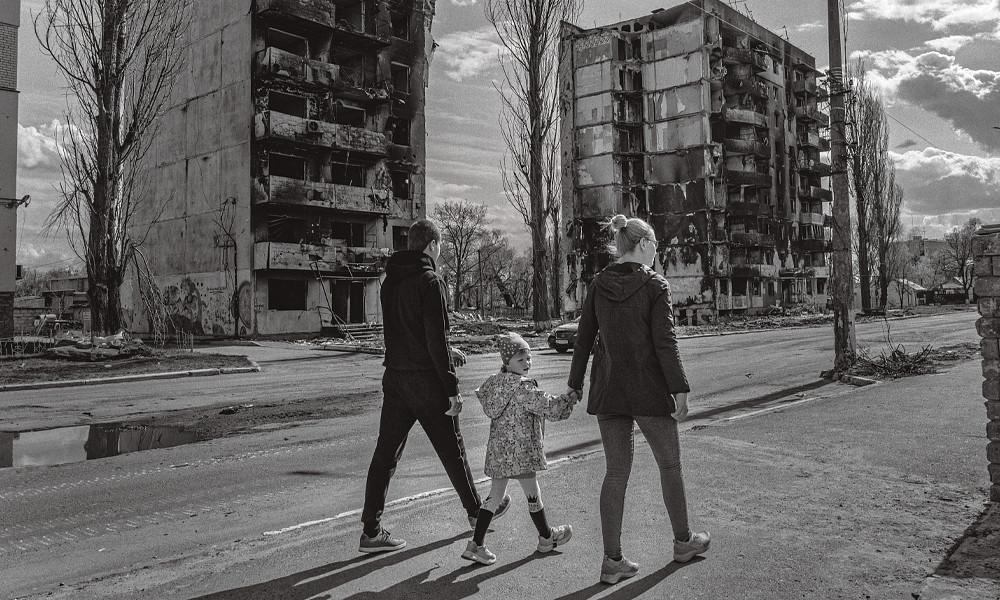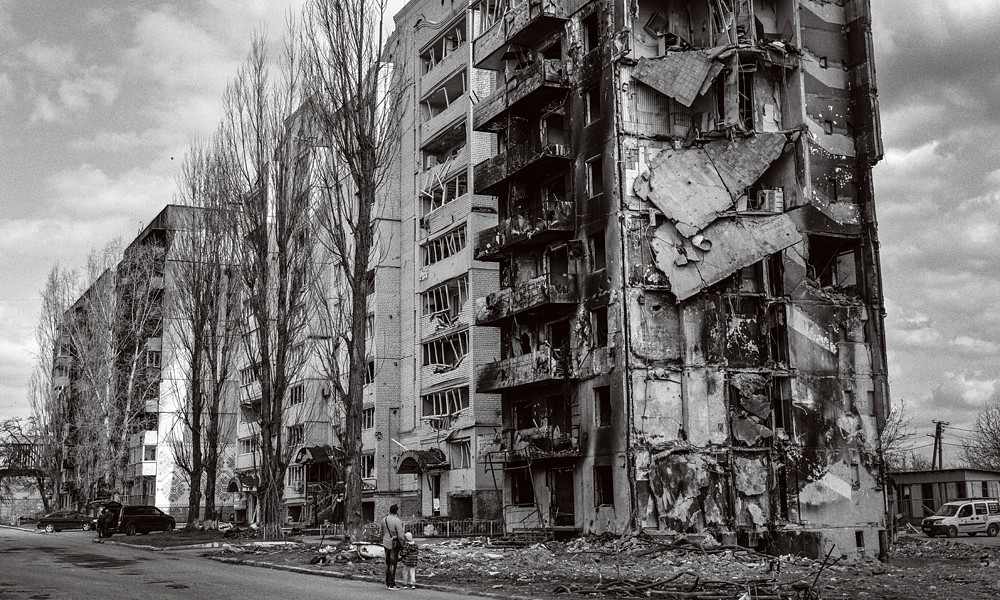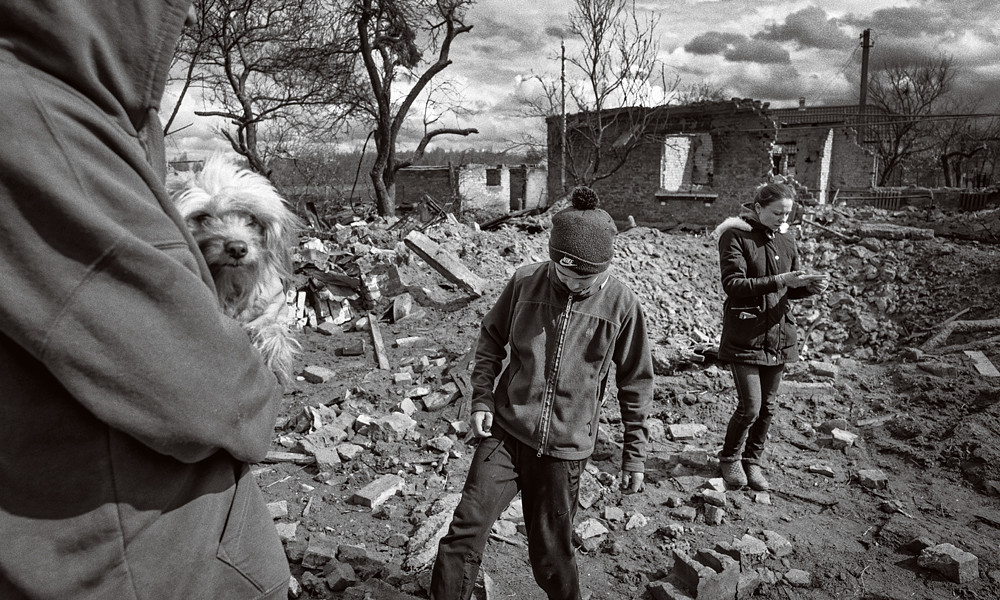The war in Ukraine
Professors frame the conflict and its impact on Europe and beyond
Featured Stories
SUMMARY: From the birth of a nation to pivotal moments in history leading up to Russia’s full-scale invasion, two faculty experts imagine a post-war Ukraine. Photo by Sean Sutton/MAG
 Birth of a nation
Birth of a nation
In the late 1980s and early 1990s, a wave of revolutionary movements swept communist dictators from power across Eastern Europe and the former Soviet Union. One of the most politically significant events of the 20th century, the fall of communism brought an end to the decades-long Cold War and unleashed dramatic political and economic changes within the countries of the former Eastern bloc. No longer dominated by party apparatchiks in Moscow, the newly emancipated countries of the post-communist region rapidly dismantled the single-party states and centrally planned economies of the communist era and forged new identities as independent nations.
Where Russian influence was most tenuous and contested during the communist period — namely, in the satellite states of Eastern Europe (Bulgaria, Czechoslovakia, East Germany, Hungary, Poland and Romania) and the Baltic republics (Estonia, Latvia and Lithuania) — the transition was marked by a decisive turn toward the West. New leaders quickly adopted democratic constitutions and free-market economic policies, and reoriented diplomatic alliances and trade relations to draw closer to Europe. Formal membership in NATO and the EU soon followed as emphatic declarations of the “Europeanization” of a large swath of the post-communist world.
Other post-communist states that were more deeply enmeshed in the Soviet system followed more complex paths as independent nations. In the former Soviet republics of Armenia, Azerbaijan, Belarus, Georgia, Moldova, Ukraine and the states of Central Asia, the post-communist period has been marked by troubled political and economic transitions and persistent Russian influence. While each nation has followed its own unique route, the countries closest to Russia’s orbit have been undeniably shaped by the gravitational pull of the former imperial power.
Of all the former communist countries, Ukraine has arguably occupied the most intensely contested position between East and West. As its Western neighbors democratized and joined the EU, Ukraine also strengthened its economic ties to Europe and, in fits and starts, laid the political groundwork for possible EU membership. At the same time, Ukraine remained firmly within the sphere of influence of Russia — a major world power with a 1,300-mile shared border and a growing resolve to reassert its influence in the Russian-speaking world (what the Kremlin refers to as Russkiy mir). In many ways, Ukrainian politics since the fall of communism have been dominated by the question of the country’s position between Russia and the West. Indeed, the most important inflection points in Ukraine’s recent history — from the Orange Revolution of 2004, to the Euromaidan Revolution of 2013-14, to the Russian full-scale invasion in 2022 — have all centered on whether Ukraine would move closer to Europe or ally itself more firmly with Russia.
 |
| Large areas of Bodoryanka, Ukraine, were destroyed during intense and sustained bombardments in 2022. Photo by Sean Sutton/MAG |
A pivotal moment
The Euromaidan Revolution proved to be a decisive moment for Ukraine. The crisis was precipitated by Ukraine’s pro-Russian president, Viktor Yanukovych, who abruptly reversed course on a trade deal with Europe, refusing to sign an association agreement with the EU due to Russian opposition. In response to the decision, massive street protests erupted in the central square of Kyiv, known as Maidan Nezalezhnosti. When Ukrainian riot police attempted to forcefully suppress the demonstrations, protestors took up arms, leading to a violent three-month standoff between civilian protesters and government forces in the heart of the Ukrainian capital. The Euromaidan Revolution culminated in Yanukovych abandoning his post and fleeing to Russia.
Russia responded by swiftly invading and annexing the Crimean peninsula in southern Ukraine, home to Russia’s most important Black Sea naval base. Russia also lent support to a burgeoning separatist movement in the Donbas region of eastern Ukraine, where armed paramilitary groups opposed to the Euromaidan Revolution seized control of government buildings and declared the Donetsk and Luhansk People’s Republics as independent states. While fighting between the separatists and the Ukrainian government was reduced by the Minsk II agreement in early 2015, the fundamental question of the direction of Ukraine was not resolved, and fighting in the Donbas continued for the next eight years. During that time, Ukrainian national identity and political opposition to Russia increased steadily among the Ukrainian population. Ukraine became stronger and more closely aligned with EU and NATO countries, while Russia’s vision of its role in world politics grew increasingly incompatible with an independent, Western-oriented Ukraine.
Russia invades
On Feb. 24, 2022, Russian President Vladimir Putin sought to resolve this dispute in his favor by initiating an all-out conventional military attack on Ukraine. Given the scale and nature of the assault, including a major offensive aimed at capturing Kyiv, the initial goal of the invasion appeared to be outright regime change. If Russia could not persuade Ukraine to move Eastward through economic incentives, political meddling or an armed separatist movement, it would invade and occupy the country directly.
Rather than achieving a rapid fait accompli, the invasion has been thwarted by Ukrainian defense forces that repelled Russian troops from Kyiv and regained most of the territory captured by Russia in the early days of the war. Far from being supplanted by a crony pro-Russian government, Ukrainian President Volodymyr Zelenskyy has risen to international fame as a hero of the resistance. Political leaders and everyday citizens around the world have rallied to support Ukraine, offering more than $100 billion in military, financial and humanitarian aid, and governments rapidly imposed major economic sanctions against Russia in an effort to undermine its ability to pay for and supply the war effort.
 |
| Raisa and Sergiy escaped the village of Ozera, Ukraine, with their son and dog on Feb. 25, 2022. Sergiy’s parents and brother-in-law did not survive. Photo by Sean Sutton/MAG |
Analysts have put forward a variety of explanations for the underlying calculus behind the Russian invasion of Ukraine. Some highlight Putin’s desire to recoup control over territories lost during the breakup of the Soviet Union and restore Russian power and prestige on the world stage. Others point to the perceived threat of growing Western influence in the post-Soviet region, particularly in the form of Western alliances like NATO and the EU.
According to this perspective, the invasion of Ukraine may be understood as a “defensive” response to Western overreach, rather than a war of aggression. Still others paint the invasion as a strategic miscalculation. After waging a series of more limited military operations in neighboring territories with relative impunity — including the Russian occupation of Crimea and the separatist war in the Donbas — many analysts believe that Putin misjudged the potential costs of the invasion. Simply put, the Kremlin overestimated Russia’s military prowess and underestimated the ability of Ukraine to fight back, as well as the willingness of Western powers to support and sustain the Ukrainian resistance.
Whatever the true motives behind the invasion, nearly all observers agree that the decision to wage war in Ukraine has resulted in significant strategic losses for Russia. Rather than restoring Russia’s standing in the world, the war has jeopardized relations with other world powers and exposed the internal weaknesses of Putin’s corrupt autocratic regime. The once-feared Russian military has suffered humiliating losses on the battlefield. Fraying Western alliances like NATO and the EU have grown stronger and more united in the face of a common threat. And the conflict has damaged Russia’s global reputation on a scale not seen since the dissolution of the Soviet Union.
Most importantly, the war has galvanized public opinion in Ukraine against Russian intervention and in favor of a politically independent, culturally distinct Ukrainian nation. Despite the deep historical connections between Russia and Ukraine, the Russian invasion has foreclosed the possibility of a future alliance between the countries. Once a nation adrift between East and West, Ukraine is no longer stuck in the middle. The future of Ukraine will be with Europe, not Russkiy mir.
|
Ukraine is no longer stuck in the middle. The future of Ukraine will be with Europe, not Russky mir. |
A humanitarian catastrophe
Despite the strategic and diplomatic successes of the Ukrainian war effort, the humanitarian consequences of the conflict have been dire. The United Nations High Commissioner for Refugees reports more than 8 million Ukrainian refugees scattered across Europe, and another 5 million forcibly displaced inside Ukraine — making this Europe’s largest and swiftest refugee crisis since World War II. Across the Atlantic, approximately 110,000 Ukrainians have been granted temporary humanitarian parole in the United States through the Uniting for Ukraine program, and more than 150,000 additional Ukrainians have entered the U.S. through other immigration channels since the war began. While many Ukrainians initially left home with the intention of returning as soon as it was safe, the increasingly protracted conflict put their plans — and their lives — on hold. The longer the war drags on, the harder it will be for those displaced by the conflict to uproot themselves again and restart their lives in Ukraine.
Inside Ukraine, the humanitarian suffering caused by the war is difficult to comprehend. Intense fighting and indiscriminate aerial bombing campaigns have killed and injured thousands, caused widespread destruction to buildings and basic infrastructure, and created major shortages and disruptions in access to food, fuel, heat, electricity and clean water. Current data from the U.N. indicates that approximately 18 million Ukrainians — close to half of the pre-war population of Ukraine — are in immediate need of humanitarian assistance. Among the most vulnerable are children, the elderly and disabled, and those trapped in Russian-occupied territories or in communities encircled by fighting on the frontlines.
 |
| John Hulsey, professor of political science, and Daniel Beers, associate professor of justice studies, join a delegation of Ukrainian public ofificials on campus hosted by the Center for International Stabilization and Recovery in March. |
Beyond the immediate dangers and disruptions to daily life, the war will exact a heavy toll on the future of Ukraine. Rebuilding the cities and towns and basic infrastructure destroyed in the conflict will take years, if not decades, and require a massive outlay of resources far beyond the capacity of the Ukrainian state. As part of their military strategy, Russian and Ukrainian forces have littered the country’s fields and forests with landmines to slow the advance of enemy troops. These munitions, and other unexploded ordnance left over from the war, will remain a danger to Ukrainian civilians for years to come. Moreover, the psychological toll of lost loved ones, families separated by the conflict and the daily traumas of war will continue to haunt survivors long after the fighting has ceased. Regardless of how the current conflict ends, the challenges of rebuilding Ukraine and healing the wounds of war cannot be overstated.
Post-war Ukraine
Ultimately, the future of Ukraine will depend heavily on the course of the conflict from this point forward and especially on how the war ends. More than one year after Russia’s fullscale invasion, a decisive military victory for either side is difficult to imagine. Rather, it appears more likely that the war will continue for some time, with possible outcomes ranging from the restoration of Ukraine’s pre-2014 borders, to a negotiated settlement, to a broader regional war. The fundamental tasks of any settlement will be to guarantee that no side views restarting the war as a useful path to pursuing their interests, while crafting a political accord that includes all Ukrainians. This latter task will be made more difficult by the need to incorporate people and territories who have opposed the Ukrainian state during the war, as well as extremists who have been radicalized and emboldened by the conflict.
What is more certain is that the war’s legacies will be long-lasting and multifaceted. Soldiers will come away with changed attitudes toward their country, their compatriots and their opponents, and will carry physical and mental scars. The structures that make daily life possible, from physical infrastructure to human relationships, are being destroyed by and adapted to the intense realities of war. Families torn apart temporarily or permanently by displacement and death will forever be shaped by the experience. The necessities of fighting and survival will create impulses for solidarity and division, strengthening some bonds and organizations while weakening others in ways that will persist long after the fighting is over. Even as we look forward to the end of war, we must prepare ourselves for the years of work it will take to build lasting peace and prosperity in post-war Ukraine.
